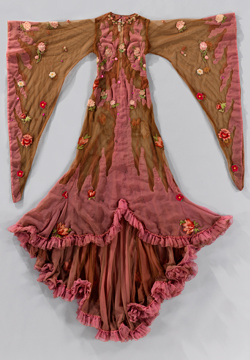When Lois K. Alexander-Lane (1916-2007) founded the Black Fashion Museum in 1979, “black fashion” was considered an anomaly. Most believed the African American community’s contributions to design were relatively recent and fairly insignificant—or worse still, they weren’t considered at all. Alexander-Lane knew this all too well. While studying for her master’s degree at New York University in 1963, she proposed a thesis on the historic role of African Americans in Manhattan retailing; her professor responded by saying African Americans played no such role. Her resulting thesis—and later her life’s work—proved otherwise.
Previously housed in a two-story row house on Vermont Avenue in Washington, D.C., the Black Fashion Museum Collection comprises more than 700 garments, 300 accessories, and 60 boxes of archival material collected by Alexander-Lane throughout her life. In 2007, Alexander-Lane’s daughter, Joyce Bailey, donated the Black Fashion Museum’s entire holdings to the National Museum of African American History and Culture. The research collection—one of the largest and rarest of its kind—includes a dress sewn by Rosa Parks shortly before her famous arrest in Montgomery, Ala.; a beige-patterned skirt worn by an enslaved child in Leesburg, Va.; the original Tin Man costume designed by Geoffrey Holder for the 1975 Broadway musical, The Wiz and a replica of the inaugural gown created for Mary Todd Lincoln in 1865 by Elizabeth Keckley, a former slave.
“The collection runs the gamut of clothing and accessories from the 19th century to the 1980s, and includes everyday wear to haute couture, as well as theater and performance costumes,” says Michèle Gates Moresi, curator of collections at the NMAAHC. “What they all share is an excellence in workmanship and design.”
Clothing and bonnets worn by slaves in the mid-1800s appear alongside an elaborately constructed opera cape made by a former slave. Other items include gowns by Ann Lowe, a pioneering African American designer whose patrons included the Rockefellers, the Du Ponts, the Vanderbilts, and Jacqueline Bouvier Kennedy. “The objects not only tell the story of black fashion,” Moresi says, “but of the women and men who created them, wore them and held on to them for years.”
Lois K. Alexander-Lane eventually published her own book, Blacks in the History of Fashion in 1982. Now that the collection is at the Smithsonian, researchers can continue to explore this rich part of history and we can learn about African Americans’ significant role in American design and fashion.





